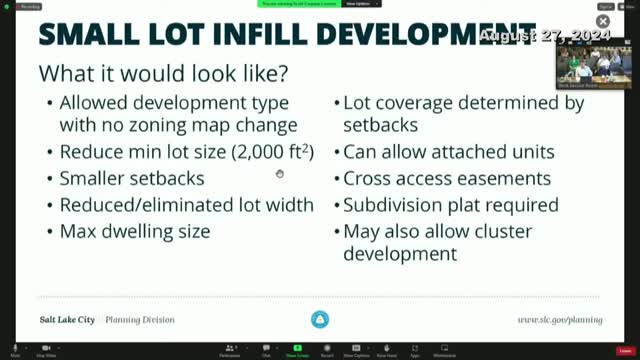Durham's small lot strategy transforms affordable housing landscape
August 27, 2024 | Salt Lake City Council and RDA Board meetings, Salt Lake City, Salt Lake County, Utah
This article was created by AI summarizing key points discussed. AI makes mistakes, so for full details and context, please refer to the video of the full meeting. Please report any errors so we can fix them. Report an error »

In a recent government meeting, officials discussed innovative housing strategies aimed at addressing affordability challenges in their city. A key focus was on a successful small lot infill initiative from Durham, North Carolina, which has been highlighted as a potential model for local implementation.
The Durham program, adopted in 2019, allows for the creation of smaller residential lots within R1 zones, significantly reducing minimum lot sizes and setbacks. This initiative led to the construction of 215 small lot homes, which sold for an average of $257,000 less than traditional homes in the area. Notably, four times as many of these homes were built in lower wealth neighborhoods compared to higher wealth areas, raising questions about potential displacement and gentrification.
Council members expressed interest in the implications of maximum dwelling sizes, which help maintain affordability by preventing the construction of oversized homes on smaller lots. This approach aims to create starter homes that can facilitate generational wealth through homeownership, a critical need in the current housing market.
Concerns were also raised about the environmental impact of increased lot coverage and reduced green spaces. However, planners noted that incorporating tree coverage and other landscaping strategies could mitigate heat and stormwater issues associated with urban development.
The discussion underscored the urgency of addressing housing affordability, particularly in light of historical zoning practices that have limited multifamily housing options. Council members acknowledged the need for a shift in policy to adapt to the current housing crisis, emphasizing that strategies effective in the past may no longer be suitable today.
As the city considers adopting similar small lot infill policies, officials are committed to ensuring that these changes promote affordability without displacing existing residents or compromising environmental quality. The meeting concluded with a consensus on the importance of further research into the demographic impacts of such housing initiatives, particularly in areas previously affected by systemic inequities.
The Durham program, adopted in 2019, allows for the creation of smaller residential lots within R1 zones, significantly reducing minimum lot sizes and setbacks. This initiative led to the construction of 215 small lot homes, which sold for an average of $257,000 less than traditional homes in the area. Notably, four times as many of these homes were built in lower wealth neighborhoods compared to higher wealth areas, raising questions about potential displacement and gentrification.
Council members expressed interest in the implications of maximum dwelling sizes, which help maintain affordability by preventing the construction of oversized homes on smaller lots. This approach aims to create starter homes that can facilitate generational wealth through homeownership, a critical need in the current housing market.
Concerns were also raised about the environmental impact of increased lot coverage and reduced green spaces. However, planners noted that incorporating tree coverage and other landscaping strategies could mitigate heat and stormwater issues associated with urban development.
The discussion underscored the urgency of addressing housing affordability, particularly in light of historical zoning practices that have limited multifamily housing options. Council members acknowledged the need for a shift in policy to adapt to the current housing crisis, emphasizing that strategies effective in the past may no longer be suitable today.
As the city considers adopting similar small lot infill policies, officials are committed to ensuring that these changes promote affordability without displacing existing residents or compromising environmental quality. The meeting concluded with a consensus on the importance of further research into the demographic impacts of such housing initiatives, particularly in areas previously affected by systemic inequities.
View full meeting
This article is based on a recent meeting—watch the full video and explore the complete transcript for deeper insights into the discussion.
View full meeting

